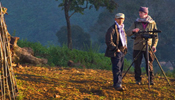
| By YENI AND JEANNE HALLACY | Saturday, September 4, 2010 |
In 1988, when thousands of young Burmese student activists arrived at the Thai-Burmese border, many enthusiastic supporters of Burma's democracy movement came to the border to share their lives with the “Student Army,” also known as the All Burma Students’ Democratic Front (ABSDF), that was born in the terrain controlled by several ethnic armed groups. Sam Sittipong Kalayanee was one of them. As a former Thai student activist, he supported the struggle for democracy and justice in his neighboring country, and as a photographer, he recorded it for history.
|
Most recently Sam co-produced an Oscar-nominated documentary film directed by Anders Østergaard which followed the September 2007 uprising against the Burmese military regime, “Burma VJ” (2009).
From activist to humanitarian worker to documentary filmmaker, Sam was always passionate about his livelihoods. In 1993, his pioneering vision led to him founding Images Asia –among the first NGOs dedicated to visual documentation of the humanitarian plight of ethnic minorities and democracy activists from Burma.
Images Asia is an alternative media production group involved in documentation, film, video and multi-media productions; and it maintains a library of video footage and photographs from not only Burma, but also throughout Southeast Asia.
In its early years, Images Asia was one of the staple locations where journalists, visiting scholars and international relief agencies could turn for compelling visual material, testimonies and evidence of the ongoing political crisis affecting both Burma and Thailand.
Known to many as “P’ Sam,” he had a profound understanding of the importance of such imagery –and he and his organization set out to recreate it as history. Tens of thousands of photographs, video clips, interviews with refugees and members of the ABSDF student army and ethnic leaders are part of this remarkable repository of Burma’s contemporary political history.
Yet Sam’s definition of “the border” was not defined by the more narrow scope of access from Thailand. He traveled to remote areas inside Shan State, Kachin State and Burma’s western border including Nagaland as a seeker of truth, as an eyewitness and a tireless advocate for the millions of ethnic people in Burma devastated by militarization, displacement and conflict. Ethnic leaders from the Shan, Karen, Kachin and Mon knew of his dedication to document and disseminate information about their plight. The Burmese student movement viewed him as their “Ako”—their elder brother.
Recently, Sam foraged through his archive of old slides and black and white photos to post an amazing array of photographs of the ABSDF’s seminal beginnings—a snapshot of history spanning 20 years. The response to these images on Facebook was overwhelming—as leaders who remain in Thailand and others who are now abroad perhaps silently shed tears as they viewed photos of young idealists intent on changing military dictatorship in Burma and quickly returning home. “The intention of posting these photos is to share the hardship in the past of the students and bravery of young hearts that sacrificed their lives for the the country,” Sam wrote on his Facebook.
Sam was unquestionably one of very few Thai experts on Burma’s complex ethnic strife, human rights abuses and culture. What made his knowledge more special was the generous way he shared it with those who seriously sought insight. Many journalists turned to Sam for his incisive analysis based on experiential knowledge.
If a newcomer approached asking for a crash course on the Burma border, an irascible smile would sneak across his face under his John Lennon-rimmed glasses, and he might pause to wipe off some dust or sweat from his brow with the tail of the ever-present checkered krama tossed around his neck. But for those who sought to grasp some piece of the harsh reality for the millions who suffered in Burma, Sam would offer contacts, assistance and guidance.
Andrew Marshall, a British author and journalist based in Southeast Asia who writes for TIME magazine and other leading publications worldwide, noted: “He was one of a kind—a passionate and engaged journalist, an esteemed and generous colleague, a free spirit, and a valued friend to many.”
There are unique individuals whose path in life is guided by passion, convictions and a definite sense of the mosaic of our shared and fleeting humanity. Sam Sittipong Kalayanee, or “P’ Sam”, as he was affectionately known was such a person. He was on a path guided by compassion. He held a compass that pointed in one direction only: the truth.
